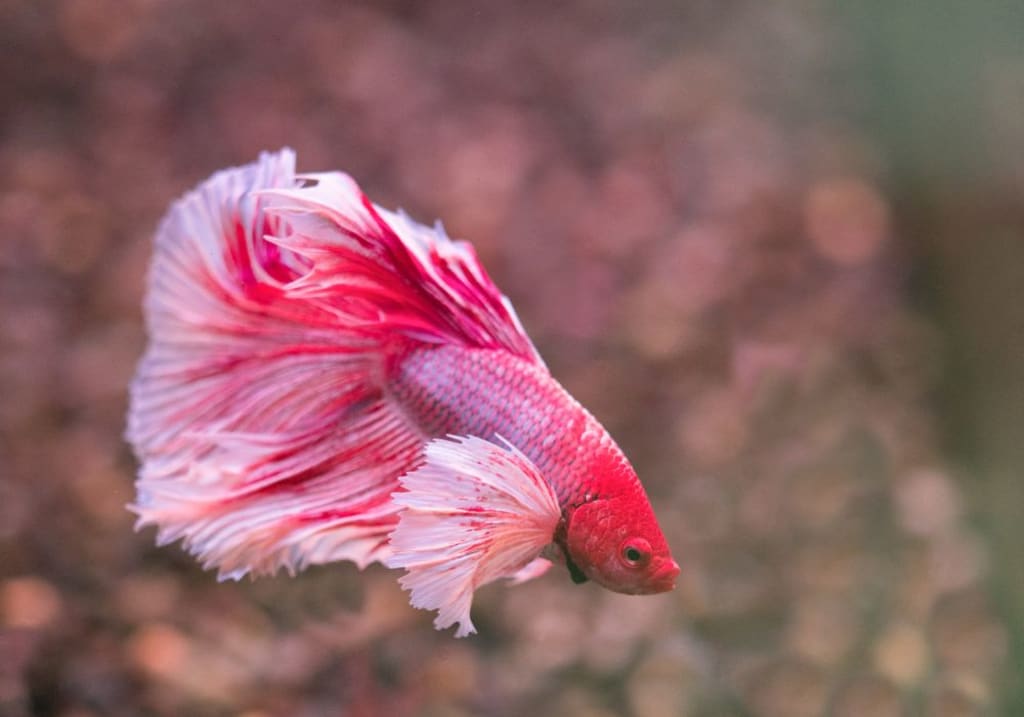Creating the Ideal Environment for Your Betta Fish
A Step-by-Step Guide

Introduction: Why Setting Up the Ideal Environment is Important for Betta Fish
Betta Fish, also known as Siamese fighting fish, are some of the most popular aquarium fish to get for home or office tanks. They are colorful, relatively inexpensive, and easy to maintain. However, if you want your Betta Fish to thrive in its home aquarium environment, you need to understand how to set up a betta fish tank properly and ensure your pet has the ideal environment. In order for your Betta Fish to stay healthy, you should create a habitat that mimics their natural habitat in Thailand's rice paddies and flooded fields.
Creating the right environment for a Betta Fish is essential for their health and overall wellbeing. It not only affects their mood but also helps them fight off diseases and other illnesses. Having the proper water temperature, pH levels, water filtration system, and other components will make all the difference in providing a safe haven for your pet Betta Fish. In this article we will provide step-by-step instructions on how to set up a betta fish tank so your pet can live happily and healthily for years to come.
Step 1: Choosing the Right Tank Size and Type
Setting up an ideal environment for your betta fish starts with selecting the right size and type of tank. How to set up a betta fish tank is a question that causes confusion for many new owners. To ensure that your fish has plenty of room to swim about and interact with their environment, experts recommend at least 2-5 gallons in tank capacity. If you’re unsure what size will be best for your betta, opt for something larger rather than smaller as this will accommodate any potential upgrades or accessories you may wish to add in the future. It’s also important to consider the shape and material of the tank, as certain materials can affect water chemistry or even be harmful to your fish.
For example, acrylic tanks are great choices due to their transparency and durability, which makes them easier to clean and maintain over time. When it comes to type, there are two options: heated tanks or cold water tanks. Heated tanks provide perfect conditions for tropical breeds like bettas, but also require additional attention when it comes to care and maintenance. Cold water tanks are best suited for colder climates as they don’t require additional heating equipment, however they need regular temperature monitoring as well as more frequent water changes in order to keep conditions suitable for bettas. No matter which type you choose, it’s important that you use a filter system when setting up your tank.
A good filter system helps keep water clean by purifying it from impurities such as ammonia or nitrates; both of which can be harmful if present in high concentrations. Additionally, make sure the tank is properly covered and secured so that your fish can’t jump out - a common issue with many types of betta fish! Choosing the right size and type of tank is essential when creating an ideal environment for your Betta fish; taking into account factors such as material choice, heating requirements and filtration systems will help ensure that your Betta is safe and comfortable throughout its life.
Step 2: Adding Substrate and Plants
When setting up the ideal environment for your betta fish, adding substrate and plants are essential components. How to set up a betta fish tank starts with the substrate, which is typically a natural gravel or sand. The substrate’s purpose is twofold: it helps to create a more comfortable environment for your betta fish by providing an area for them to hide and rest, and also helps to keep the tank looking aesthetically pleasing. When choosing the right substrate, consider its color, size, shape, texture, and weight – all factors that can help protect both your Betta’s fins as well as any other inhabitants in the tank.
In addition to the substrate, it is suggested that you add some plants to your betta fish’s environment. Live plants are ideal because they provide shade, comfort for your Betta Fish while they rest, and can even help reduce ammonia levels in the water. When adding live plants to your aquarium be mindful of the types of plants you choose as some may require more light than others. Additionally, make sure that any plastic or artificial plants don’t have sharp edges that could harm your Betta Fish if they get too close.
By following this step-by-step guide on how to set up a betta fish tank with adding substrate and plants will provide an ideal safe haven for your new friend who will bring joy and excitement into your life. With careful selection of materials for both aesthetics as well as safety considerations you can create an inviting home for your new Betta Fish.
Step 3: Selecting Appropriate Decorations
Creating the ideal environment for your beloved betta fish starts with selecting appropriate decorations for your tank. Once you have chosen the right size tank and added a few essential items, it is time to add decorations and begin setting up a space that will make your betta feel at home. When selecting decorations, it is important to keep in mind that bettas are naturally found in things like rice paddies, streams and small ponds. This means that creating an environment with lots of plants, both natural or artificial, is key. Your betta’s tank should also feature elements like rocks, driftwood and other decorations that mimic their natural habitats.
When selecting decorations for your betta’s tank, opt for items made from non-toxic materials or plastics that won’t leach anything into the water. Additionally, when adding plants to the tank make sure they have been properly treated before placement to reduce any potential harm caused by chlorine or other chemicals in the water. Consider purchasing live plants as opposed to plastic ones as they can help maintain water quality and provide shelter for your fish. Lastly, choose decorations that are easy to clean and have no sharp edges or corners which could harm your betta fish’s fins.
If you take these steps when selecting decorations for your betta fish tank, you will be on track to creating an ideal environment that meets all its needs! How to set up a betta fish tank requires careful consideration of choosing appropriate decorations for creating the perfect home for your pet as well as maintaining proper water quality levels.
Step 4: Installing a Filter and Heater
Now that you've chosen the perfect tank for your betta fish, it's time to install all the necessary equipment and create an ideal environment for your new pet. Installing a filter and heater are essential steps in setting up a betta fish tank, as these two pieces of equipment will ensure proper water movement and temperature control. This will help keep your betta healthy and happy.
When setting up a filter, it's important to choose one that is appropriate for the size of your tank. Too powerful of a filter can cause too much water movement for your betta, so make sure to select one with adjustable power levels. Additionally, make sure to clean the filter regularly to prevent any buildup of debris or dirt that may affect the quality of the water in your tank.
Heaters are also key components in creating an ideal environment for your betta. Be sure to use an adjustable heater so you can easily adjust the temperature based on what is most comfortable for your fish. As bettas prefer temperatures between 75-80 degrees Fahrenheit, it's best to set it at 78 degrees Fahrenheit or slightly higher if needed. Make sure to check on the temperature periodically as any sudden changes could be unhealthy or even fatal to your fish.
Once you have installed both the filter and heater, be sure to give them some time before introducing your betta into its new home. It's important to let everything run properly before adding any living creatures!
Step 5: Testing and Adjusting the Water Parameters
Setting up a betta fish tank requires careful testing and adjustment of water parameters. The quality of the water, which includes factors like temperature, pH, ammonia, nitrate and nitrite levels must be closely monitored to ensure a healthy environment for your betta fish. High levels of ammonia are especially dangerous and can cause your fish to become ill or even die. Therefore, it is essential that you check the pH level using a test strip or kit before introducing your betta into its new home. Once you have determined the pH level of your aquarium water, you may need to adjust it to make sure it is in an ideal range for your fish (typically 6.5-7.5).
You can do this by adding a buffer solution that will bring your aquarium's pH up or down as needed. Additionally, you can also use live plants such as hornwort and java moss to help maintain ideal water quality levels in the aquarium. When adjusting the water parameters, it is important to keep in mind that sudden changes can be harmful for your betta fish. Therefore, it is best to make any adjustments gradually over time so that your fish can easily adapt to its new environment without any stress or risk of injury. In conclusion, testing and adjusting the water parameters in your betta fish tank is an essential step when setting up the ideal environment for your fish.
Careful monitoring must be done regularly throughout the process in order to ensure that all parameters are within ideal ranges for a healthy aquatic environment. With patience and dedication, creating an ideal habitat for your betta will eventually bring great rewards!
Conclusion: Tips for Maintaining the Ideal Environment for Your Betta Fish
Creating the ideal environment for your betta fish is a simple process that requires some initial thought and preparation. Once the tank is set up, there are some crucial steps to take to maintain the perfect environment. It's important to observe your betta fish and check the water parameters regularly. The temperature in the tank should remain consistent, ideally between 76-82 degrees Fahrenheit, while regular partial water changes will help keep the water clean and free of toxins.
Additionally, using a suitable filter and aeration system will help keep oxygen levels high and ensure an ideal habitat for your fish. It's essential to provide a variety of colorful plants and decorations in order to provide your betta with plenty of hiding spots, as well as to create a visually pleasing environment for you! Finally, be sure to feed your fish high-quality food with plenty of protein in order to give them all the essential nutrition they need.
About the Creator
Hasan
Welcome...
In this site of mine you can learn amazing things and many information that you don't know so please subscribe to my site.
Enjoyed the story? Support the Creator.
Subscribe for free to receive all their stories in your feed. You could also pledge your support or give them a one-off tip, letting them know you appreciate their work.






Comments
There are no comments for this story
Be the first to respond and start the conversation.